Gorilla Tourism In Rwanda offers an unparalleled wildlife encounter, and SIXT.VN makes planning your adventure seamless and stress-free. With our comprehensive services, including airport transfers, hotel bookings, and guided tours, you can focus on the experience of a lifetime: observing majestic gorillas in their natural habitat. Let SIXT.VN be your trusted partner for gorilla trekking permits, eco-tourism, and sustainable travel.
1. What Makes Gorilla Tourism in Rwanda So Special?
Gorilla tourism in Rwanda provides a deeply moving experience, offering the chance to observe endangered mountain gorillas in their natural environment. These treks are carefully managed, ensuring the gorillas’ safety and well-being while allowing visitors a rare glimpse into their lives.
Witnessing gorillas in their natural habitat is an extraordinary event that many describe as unforgettable. These managed encounters, guided by expert trackers, involve small groups hiking through bamboo-covered slopes. The reward? A precious hour spent just a few feet away from these gentle giants, observing their daily routines. According to a report by the Rwanda Development Board in 2023, gorilla tourism contributes significantly to conservation efforts and local community development.
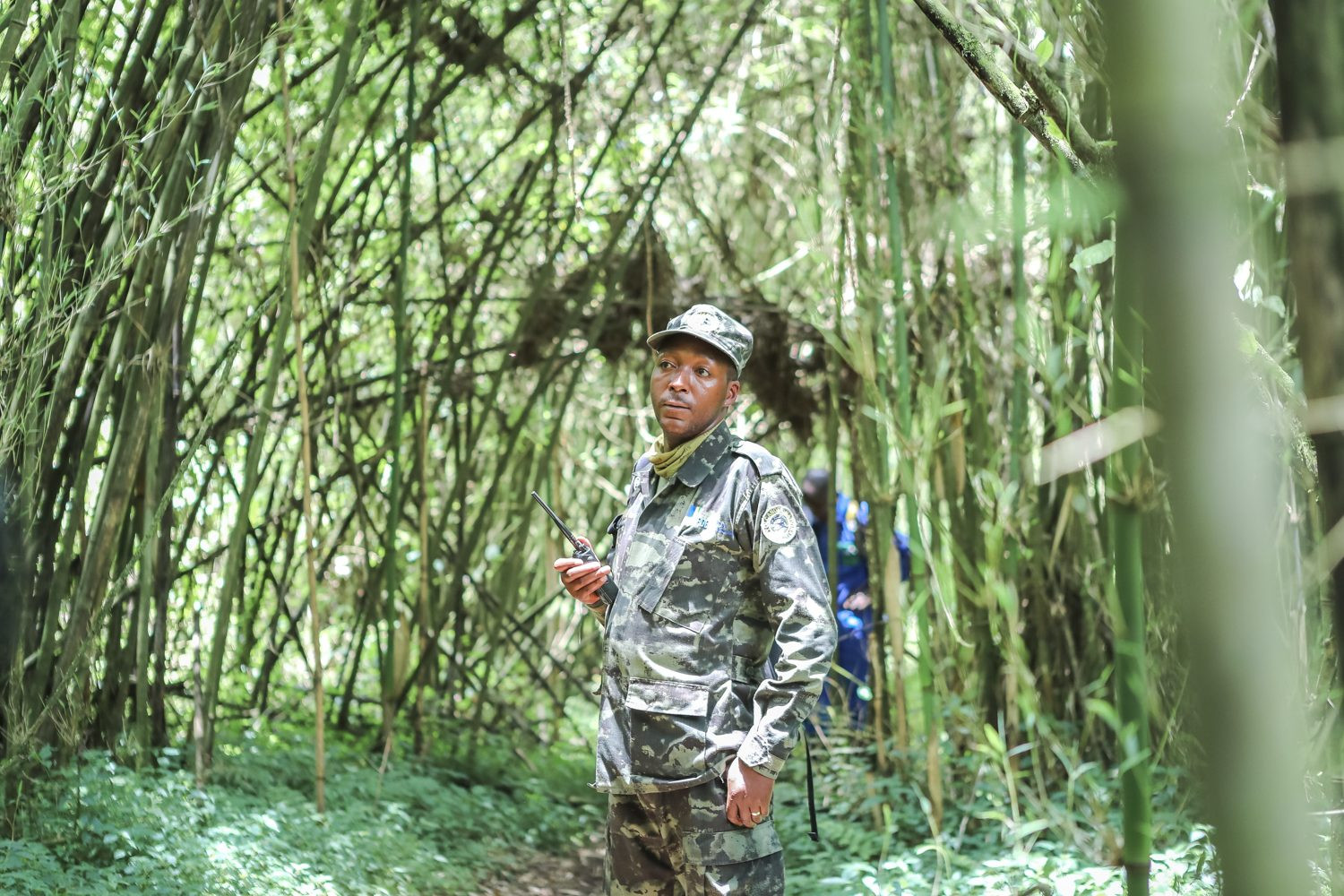 Tourists watching a gorilla in its natural habitat in Rwanda
Tourists watching a gorilla in its natural habitat in Rwanda
Why Rwanda?
Rwanda is notably safe and accessible for gorilla tracking compared to other locations. The country has invested heavily in infrastructure and conservation, making it a premier destination for this unique wildlife experience.
2. Where Can You Find Gorillas in Rwanda?
Mountain gorillas primarily inhabit the Virunga Massif, a volcanic range spanning Rwanda, Uganda, and the Democratic Republic of Congo. In Rwanda, these gorillas are found in Volcanoes National Park.
The Volcanoes National Park, located in the Virunga Mountains, is the Rwandan sanctuary for mountain gorillas. At the last count, approximately 1,000 mountain gorillas exist in the wild, with 604 residing in the Virunga Massif. Thanks to the combined efforts of governments, local communities, and NGOs, the population is gradually increasing.
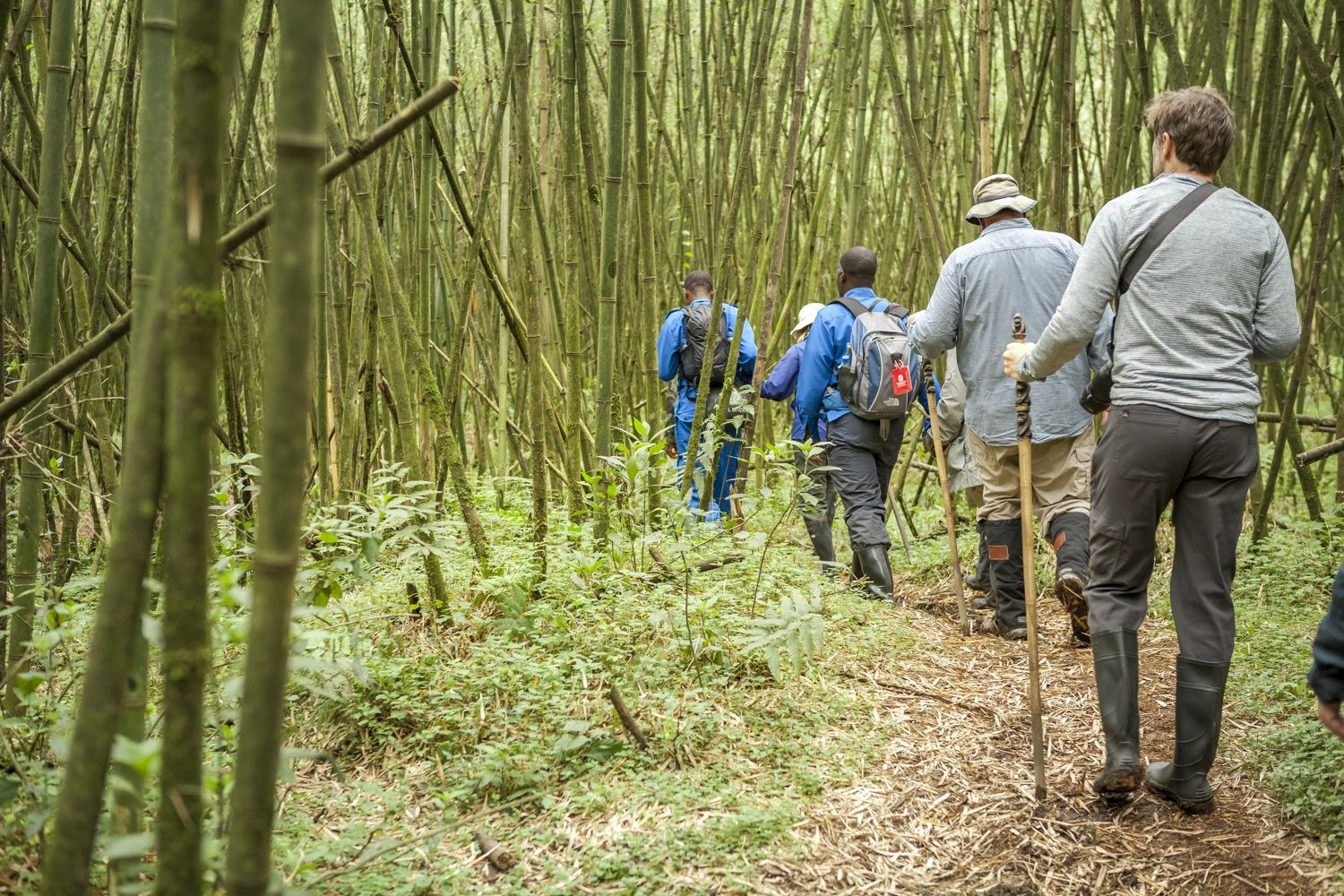 Tourists hiking up a mountain in Rwanda for gorilla tourism
Tourists hiking up a mountain in Rwanda for gorilla tourism
What is a Gorilla Family Troop?
There are twelve habituated gorilla families in Volcanoes National Park, open to tourists, with additional groups reserved for scientific research. Each troop consists of at least one dominant silverback, along with several females and their offspring. These troops are monitored and protected by park rangers, ensuring their safety and well-being. Tourist groups are allowed a strict one-hour maximum visit per day to minimize disturbance.
3. How Does Rwanda Protect its Gorilla Population?
Rwanda implements stringent conservation measures, including daily monitoring, limited tourist interaction, and community involvement, to protect its gorilla population.
Conservation is a top priority in Rwanda. Park rangers constantly monitor and protect the gorilla families, and tourist encounters are strictly limited to one hour per day. These measures help to ensure the gorillas’ well-being and minimize human impact on their habitat. The Rwandan government also allocates a significant portion of tourism revenue to support local communities, fostering a sense of stewardship and shared responsibility for gorilla conservation.
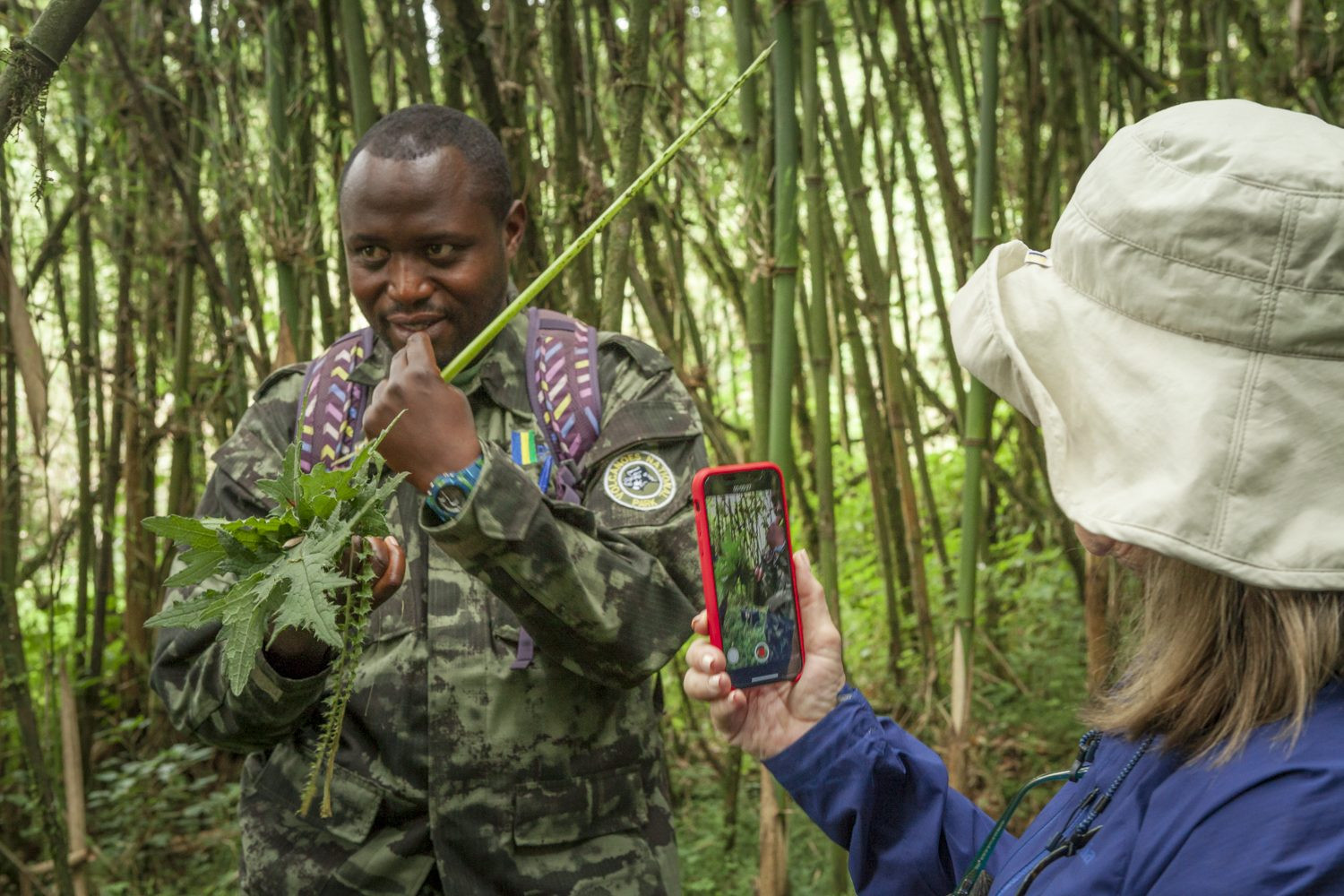 A park ranger explaining rules to tourists before gorilla tracking
A park ranger explaining rules to tourists before gorilla tracking
How Are Local Communities Involved?
Ten percent of the revenue from gorilla tracking permits is allocated to local communities for building schools, health centers, and roads. Additionally, a compensation fund is available for farmers whose crops are damaged by gorillas, promoting peaceful coexistence. Gorilla tourism provides employment for many locals, including rangers, trackers, porters, drivers, and lodge staff.
According to the International Gorilla Conservation Programme (IGCP), community involvement is crucial for the long-term survival of gorillas. By providing economic benefits and addressing potential conflicts, local communities become active participants in conservation efforts.
4. How Can I Secure a Gorilla Tracking Permit?
You can book gorilla tracking permits online or through a reputable tour operator like SIXT.VN. With only 96 permits available each day, booking in advance is highly recommended to ensure you don’t miss out.
Given the limited number of permits, securing one well in advance is crucial. You can book online through the official Rwanda Development Board website or, for a hassle-free experience, book through SIXT.VN. We can handle all the arrangements, including permits, transportation, and accommodation, ensuring a seamless and memorable adventure.
![]() A tourist holding a gorilla tracking permit badge
A tourist holding a gorilla tracking permit badge
What is the Cost of a Gorilla Permit in Rwanda?
As of 2024, a gorilla tracking permit in Rwanda costs $1,500 USD per person. This fee contributes to gorilla conservation efforts and local community development.
What Does SIXT.VN Offer?
SIXT.VN provides comprehensive travel packages for gorilla tourism in Rwanda, including permit acquisition, transportation, accommodation, and guided tours. Our expert team ensures a seamless and unforgettable experience, tailored to your preferences. We also offer services such as airport transfers and hotel bookings in Hanoi.
5. What Should I Expect on a Gorilla Trek?
Visitors gather at the Volcanoes National Park headquarters in Kinigi at 7am, where they are assigned a gorilla family based on fitness levels. The trek can last from 30 minutes to four or more hours, reaching altitudes between 2,500m and 4,000m. Porters are available to assist with carrying backpacks and cameras and to offer a helping hand.
A typical gorilla trek begins early in the morning at the Volcanoes National Park headquarters in Kinigi. Here, visitors are briefed on the rules and protocols for visiting the gorillas and assigned to a specific gorilla family. The hike to reach the gorillas can vary in duration and difficulty, depending on the location of the assigned family.
![]() Tourists with gorilla trackers walking in Rwanda
Tourists with gorilla trackers walking in Rwanda
What Are the Names of the Gorilla Families?
The habituated gorilla families include Susa, Igisha, Karisimbi, Sabyinyo, Amahoro, Agashya, Kwitonda, Umubano, Hirwa, Bwenge, Ugyenda, and Muhoza. Each family offers a unique viewing experience.
What Fitness Level is Required?
Gorilla trekking can be physically demanding, requiring a reasonable level of fitness. However, park rangers take into account visitors’ fitness levels when assigning gorilla families. Porters are available to assist with carrying equipment and providing support during the trek.
6. What Should I Pack for a Gorilla Trek?
Essential items for a gorilla trek include sturdy hiking boots, rain gear, long pants and sleeves, gloves, a hat, sunscreen, insect repellent, and a water bottle. A camera is also a must for capturing the unforgettable moments.
Preparing adequately for your gorilla trek ensures a comfortable and enjoyable experience. Key items to pack include:
-
Hiking Boots: Sturdy and comfortable hiking boots are essential for navigating the sometimes challenging terrain.
-
Rain Gear: The weather in the Virunga Mountains can be unpredictable, so it’s important to pack a waterproof jacket and pants.
-
Long Pants and Sleeves: These will protect you from stinging nettles and insects.
-
Gloves: Gardening gloves can be useful for gripping vegetation during the trek.
-
Hat: A hat will protect you from the sun and rain.
-
Sunscreen: Protect your skin from the strong African sun.
-
Insect Repellent: Mosquitoes and other insects can be present in the forest.
-
Water Bottle: Staying hydrated is crucial during the trek.
-
Camera: Don’t forget your camera to capture the incredible moments you’ll experience.
7. When Is the Best Time to Visit Rwanda for Gorilla Tracking?
The best time for gorilla tracking in Rwanda is during the dry seasons, from June to September and December to February. These months offer the most favorable weather conditions for hiking.
The dry seasons generally provide the best conditions for trekking, with less rain and clearer trails. However, gorilla tracking is possible year-round, and each season offers a unique experience. The rainy seasons (March-May and October-November) can be more challenging due to muddy trails but offer lush scenery and fewer tourists.
8. What is the Kwita Izina Gorilla-Naming Ceremony?
The annual Kwita Izina gorilla-naming ceremony is a significant event that celebrates Rwanda’s conservation efforts. Visitors can participate in guided tours leading up to the ceremony, meet park staff and conservationists, and attend cultural evenings.
The Kwita Izina ceremony is a unique and inspiring event that highlights Rwanda’s commitment to gorilla conservation. During the ceremony, baby gorillas born in the past year are given names in a colorful celebration of Rwandan culture and conservation success.
 Visitors at Kwita Izina gorilla-naming ceremony
Visitors at Kwita Izina gorilla-naming ceremony
What Can I Expect at the Ceremony?
The ceremony includes music, dancing, and discussions about Rwanda’s advancements in gorilla conservation and the challenges that remain. It’s a memorable experience that offers insight into the country’s dedication to protecting its natural heritage.
9. Who Was Dian Fossey and Why is She Important?
Dian Fossey was a renowned primatologist who dedicated her life to studying and protecting mountain gorillas in Rwanda. Her groundbreaking research and conservation efforts brought international attention to the plight of these endangered animals.
Dian Fossey’s work was instrumental in raising awareness about the threats facing mountain gorillas and inspiring conservation efforts around the world. Her book, “Gorillas in the Mist,” and the subsequent film adaptation brought the gorillas’ story to a global audience.
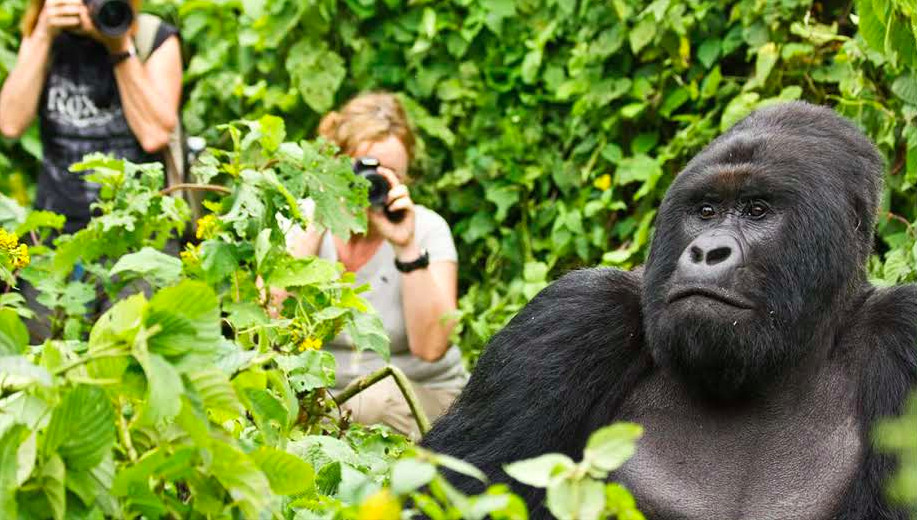 Dian Fossey gorilla conservation activities in Rwanda
Dian Fossey gorilla conservation activities in Rwanda
Can I Visit Her Tomb?
Yes, you can visit Dian Fossey’s tomb, located a 30-minute drive from the park headquarters, followed by a two to three-hour hike through the forest. It’s a pilgrimage for many who admire her work and dedication.
10. Which Conservation Organizations Work in Rwanda?
Several organizations are dedicated to gorilla conservation in Rwanda, including the Dian Fossey Gorilla Fund International, The Gorilla Organisation, International Gorilla Conservation Organisation, Gorilla Doctors, and Wildlife Conservation Society.
These organizations play a vital role in protecting gorillas through research, monitoring, anti-poaching patrols, and community engagement. They work closely with the Rwandan government and local communities to ensure the long-term survival of mountain gorillas. According to the Wildlife Conservation Society, collaborative efforts are essential for effective conservation.
11. How Does Gorilla Tourism Benefit Rwanda?
Gorilla tourism significantly contributes to Rwanda’s economy through permit fees, accommodation, and other tourist-related expenditures. It also supports local communities through employment and revenue-sharing initiatives.
The economic benefits of gorilla tourism extend beyond the tourism sector. The revenue generated is used to improve infrastructure, education, and healthcare in local communities, creating a positive cycle of development and conservation.
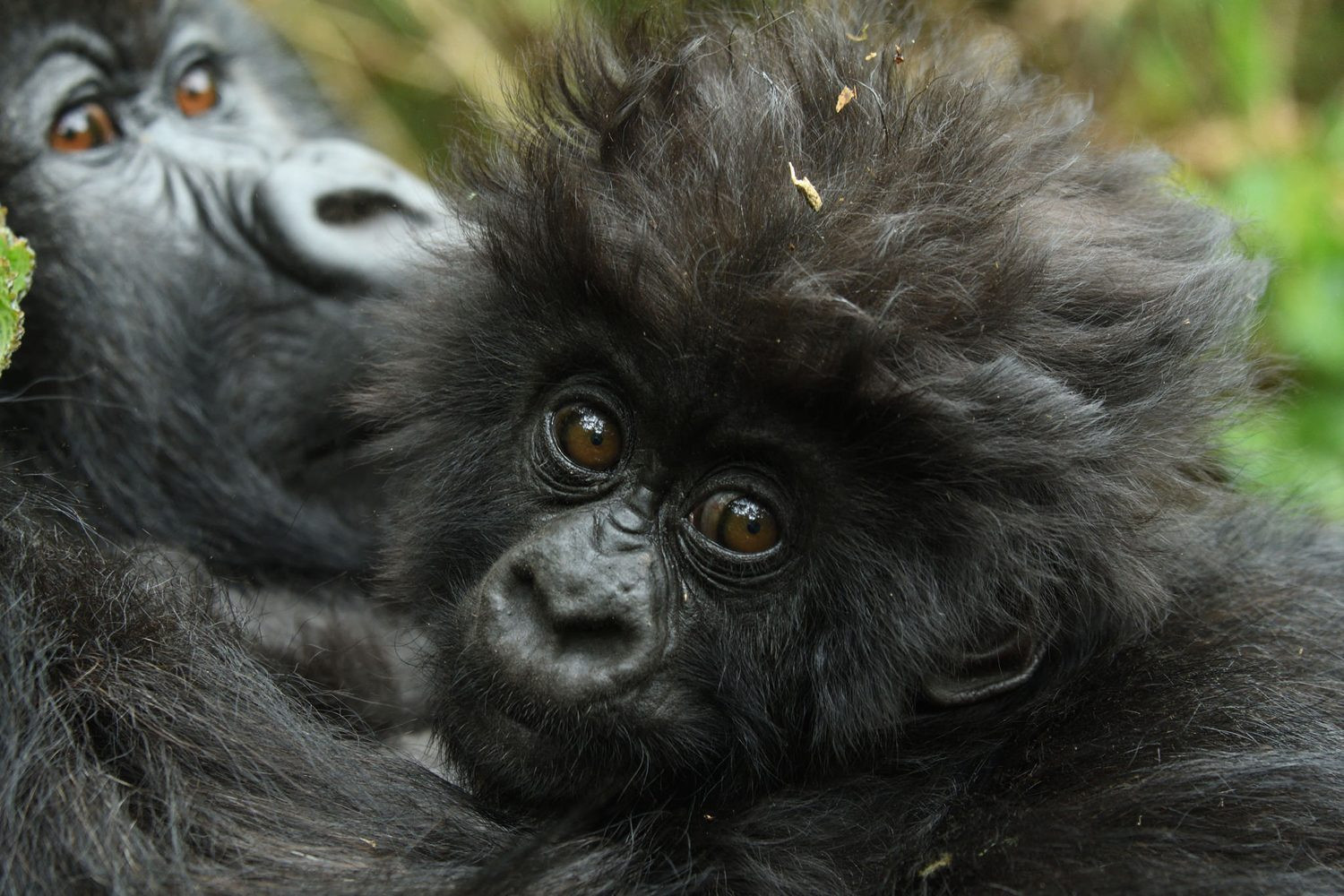 Baby Gorilla in Rwanda
Baby Gorilla in Rwanda
12. What Other Activities Can I Combine With Gorilla Tracking?
Rwanda offers a range of activities to complement your gorilla tracking experience, including wildlife safaris in Akagera National Park, chimpanzee tracking in Nyungwe Forest, and exploring the cultural heritage of Kigali.
Combining gorilla tracking with other activities allows you to experience the diverse landscapes and cultural attractions of Rwanda. Here are some popular options:
-
Wildlife Safaris in Akagera National Park: Explore Rwanda’s savanna ecosystem and spot lions, elephants, giraffes, and other wildlife.
-
Chimpanzee Tracking in Nyungwe Forest: Hike through the lush rainforest and observe chimpanzees in their natural habitat.
-
Cultural Heritage of Kigali: Visit the Kigali Genocide Memorial, explore local markets, and learn about Rwandan art and culture.
13. How Can SIXT.VN Enhance My Gorilla Tourism Experience in Rwanda?
SIXT.VN offers comprehensive travel packages that simplify your journey, providing seamless airport transfers, comfortable accommodation, and expertly guided tours, allowing you to focus on the adventure.
With SIXT.VN, planning your gorilla tourism adventure in Rwanda becomes effortless. We handle all the logistics, from securing permits and arranging transportation to booking accommodation and organizing guided tours. Our experienced team is dedicated to providing personalized service and ensuring that every aspect of your trip exceeds your expectations. Contact us at Hotline/WhatsApp: +84 986 244 358 or visit our website SIXT.VN for more details.
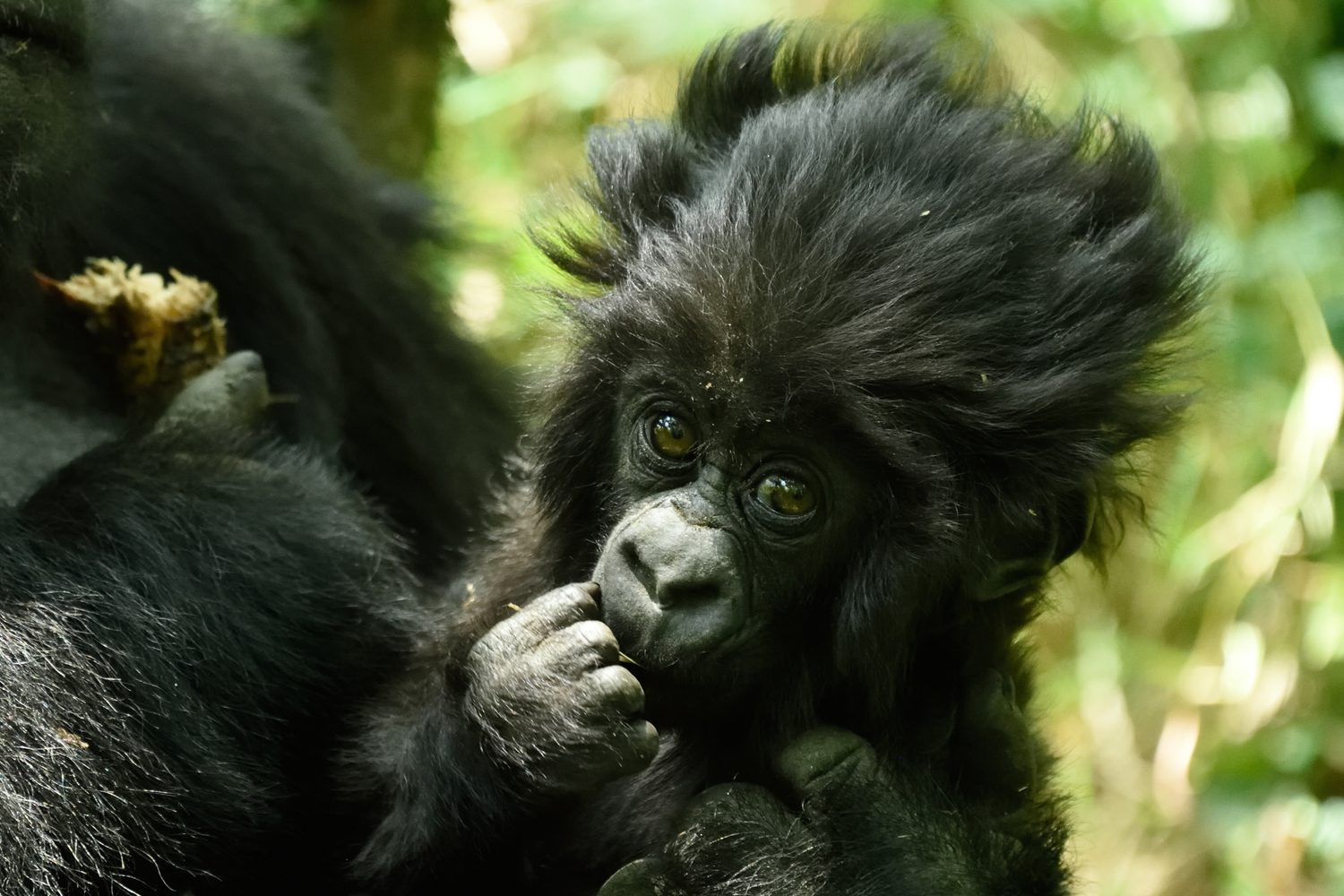 Baby Gorilla in Rwanda
Baby Gorilla in Rwanda
What Specific Services Does SIXT.VN Provide for Travelers to Hanoi?
For travelers stopping over in Hanoi, SIXT.VN offers convenient airport transfers, a wide selection of hotels to suit every budget, and guided tours of the city’s iconic landmarks and cultural attractions. Our services ensure a smooth and enjoyable experience in Hanoi. We can also assist with booking flights to Kigali and other destinations.
14. How Safe is Gorilla Tourism in Rwanda?
Gorilla tourism in Rwanda is considered safe due to the country’s political stability, well-trained park rangers, and strict safety protocols. The Rwandan government prioritizes the safety of tourists and gorillas alike.
The Rwandan government has invested heavily in security measures to ensure the safety of tourists visiting Volcanoes National Park. Park rangers are well-trained in handling potential risks and protecting both tourists and gorillas. Additionally, strict safety protocols are in place to minimize the risk of disease transmission and ensure that tourists maintain a safe distance from the gorillas.
15. What are the Rules and Guidelines for Gorilla Tracking?
Rules include maintaining a distance of at least 7 meters from gorillas, avoiding direct eye contact, and refraining from eating or drinking near the gorillas. These guidelines protect both the gorillas and the tourists.
Before embarking on your gorilla trek, you will receive a thorough briefing on the rules and guidelines for interacting with the gorillas. These rules are designed to minimize disturbance to the gorillas and ensure your safety. Key guidelines include:
-
Maintain a Distance of at Least 7 Meters: This helps to prevent the transmission of diseases between humans and gorillas.
-
Avoid Direct Eye Contact: Direct eye contact can be interpreted as a sign of aggression by gorillas.
-
Refrain from Eating or Drinking Near the Gorillas: Food and drinks can attract insects and disturb the gorillas.
-
Speak in a Low Voice: Loud noises can startle the gorillas.
-
Follow Your Guide’s Instructions: Your guide is an expert in gorilla behavior and will provide guidance throughout the trek.
16. How Does Rwanda Ensure Sustainable Gorilla Tourism?
Rwanda promotes sustainable tourism by limiting the number of permits issued daily, investing in community development, and implementing strict environmental protection measures. These efforts ensure the long-term preservation of the gorilla habitat.
Sustainable tourism is a key priority for Rwanda. By limiting the number of permits issued daily, the country minimizes the impact of tourism on the gorilla population and their habitat. Additionally, a portion of tourism revenue is invested in community development projects, providing economic benefits to local communities and fostering a sense of stewardship for the gorillas. Strict environmental protection measures are also in place to ensure the long-term preservation of the gorilla habitat.
 A Silverback Gorilla in Volcanoes National Park, Rwanda
A Silverback Gorilla in Volcanoes National Park, Rwanda
17. What Type of Accommodation is Available Near Volcanoes National Park?
Accommodation options near Volcanoes National Park range from budget-friendly guesthouses to luxury lodges, catering to different preferences and budgets. Many lodges offer stunning views of the surrounding mountains and forests.
Whether you’re looking for a comfortable and affordable guesthouse or a luxurious lodge with all the amenities, you’ll find a range of accommodation options near Volcanoes National Park. Many lodges offer stunning views of the surrounding mountains and forests, providing a memorable backdrop for your gorilla tourism adventure. SIXT.VN can help you find the perfect accommodation to suit your needs and budget.
18. What Impact Does Tourism Have on Gorilla Behavior?
Habituation efforts and strict guidelines minimize negative impacts on gorilla behavior. Research suggests that well-managed tourism can actually benefit gorilla conservation by raising awareness and generating revenue for protection efforts.
While tourism can potentially have negative impacts on gorilla behavior, Rwanda has implemented strict measures to minimize these risks. These measures include limiting the number of tourists allowed to visit each gorilla family, maintaining a safe distance from the gorillas, and educating tourists about proper behavior. Research suggests that well-managed tourism can actually benefit gorilla conservation by raising awareness and generating revenue for protection efforts.
19. How Do Trackers Locate the Gorilla Families Each Day?
Experienced trackers use their knowledge of gorilla behavior and habitat to locate the gorilla families each day. They follow tracks, listen for calls, and look for signs of recent activity.
Trackers are essential to the success of gorilla tourism in Rwanda. They are highly skilled in locating the gorilla families and ensuring that tourists have a safe and enjoyable experience. Trackers spend hours each day tracking the gorillas, using their knowledge of gorilla behavior and habitat to find them. They follow tracks, listen for calls, and look for signs of recent activity.
20. What Should I Do if a Gorilla Approaches Me?
If a gorilla approaches you, remain calm, avoid direct eye contact, and slowly back away. Follow your guide’s instructions. Gorillas are generally gentle creatures, and aggressive encounters are rare.
While aggressive encounters with gorillas are rare, it’s important to know what to do if a gorilla approaches you. The key is to remain calm and avoid any sudden movements. Avoid direct eye contact, as this can be interpreted as a sign of aggression. Slowly back away, giving the gorilla plenty of space. Follow your guide’s instructions, as they are experienced in handling these situations.
21. How Does the Rwandan Government Support Gorilla Conservation?
The Rwandan government prioritizes gorilla conservation through legislation, funding for park management, and collaboration with conservation organizations and local communities.
The Rwandan government recognizes the importance of gorilla conservation and has made it a national priority. The government has enacted legislation to protect gorillas and their habitat, provides funding for park management, and collaborates with conservation organizations and local communities to ensure the long-term survival of these magnificent animals.
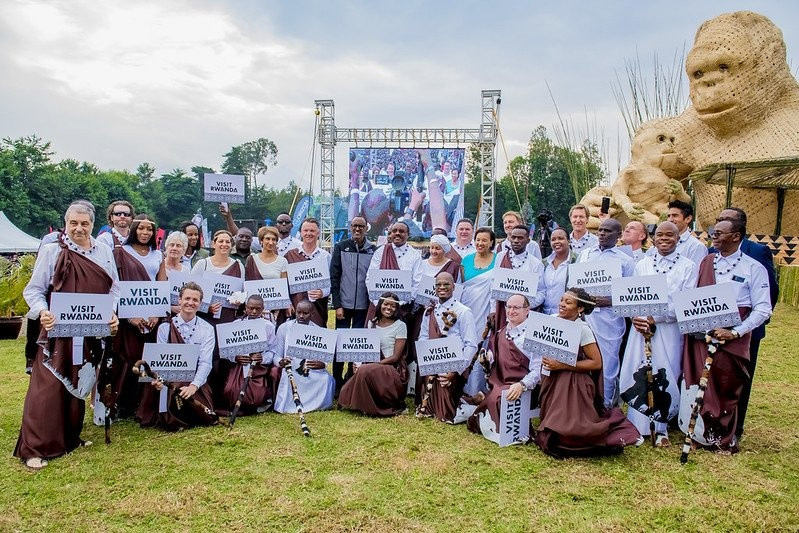 Baby Gorilla in Rwanda at the Kwita Izina ceremony
Baby Gorilla in Rwanda at the Kwita Izina ceremony
22. What are the Long-Term Goals for Gorilla Conservation in Rwanda?
The long-term goals include increasing the gorilla population, expanding their habitat, and ensuring the continued involvement of local communities in conservation efforts.
Rwanda’s long-term goals for gorilla conservation are ambitious but achievable. These goals include increasing the gorilla population, expanding their habitat, and ensuring the continued involvement of local communities in conservation efforts. By working together, the Rwandan government, conservation organizations, and local communities can ensure that these magnificent animals thrive for generations to come.
23. How Does Climate Change Affect Gorilla Tourism in Rwanda?
Climate change poses a threat to gorilla habitats and the availability of resources. Conservation efforts are increasingly focused on mitigating these effects and ensuring the long-term resilience of the gorilla population.
Climate change is a growing threat to gorilla tourism in Rwanda. Changes in temperature and rainfall patterns can affect gorilla habitats and the availability of resources. Conservation efforts are increasingly focused on mitigating these effects and ensuring the long-term resilience of the gorilla population. This includes protecting and restoring gorilla habitats, promoting sustainable tourism practices, and working with local communities to adapt to the changing climate.
24. Can Children Participate in Gorilla Tracking?
The minimum age for gorilla tracking in Rwanda is 15 years old. This rule is in place to protect both the children and the gorillas.
Due to the physical demands of gorilla tracking and the potential risks involved, the minimum age for participation is 15 years old. This rule is in place to protect both the children and the gorillas.
25. How Can I Learn More About Gorilla Conservation Before My Trip?
You can visit the websites of conservation organizations working in Rwanda, read books and articles about gorillas, and watch documentaries about their lives and conservation efforts.
Before embarking on your gorilla tourism adventure in Rwanda, you can learn more about gorilla conservation by visiting the websites of conservation organizations working in Rwanda, such as the Dian Fossey Gorilla Fund International and the International Gorilla Conservation Programme. You can also read books and articles about gorillas, and watch documentaries about their lives and conservation efforts. This will help you to appreciate the importance of gorilla conservation and to be a responsible tourist during your trip.
26. What Are Some Common Misconceptions About Gorillas?
Common misconceptions include the belief that gorillas are aggressive and dangerous. In reality, they are gentle and intelligent creatures that only become aggressive when threatened.
One of the most common misconceptions about gorillas is that they are aggressive and dangerous. In reality, they are gentle and intelligent creatures that only become aggressive when threatened. They are social animals that live in family groups and have complex communication skills. By learning more about gorillas, you can dispel these misconceptions and appreciate their true nature.
27. What Research is Being Conducted on Gorillas in Rwanda?
Research focuses on understanding gorilla behavior, health, genetics, and the impact of tourism and other human activities on their populations.
Research plays a vital role in informing conservation efforts and ensuring the long-term survival of gorillas. Research projects focus on understanding gorilla behavior, health, genetics, and the impact of tourism and other human activities on their populations. This research helps to inform conservation strategies and to ensure that tourism is managed in a sustainable way.
28. How Can I Contribute to Gorilla Conservation After My Trip?
You can donate to conservation organizations, support sustainable tourism practices, and spread awareness about the importance of gorilla conservation.
Even after your trip to Rwanda, you can continue to contribute to gorilla conservation by donating to conservation organizations, supporting sustainable tourism practices, and spreading awareness about the importance of gorilla conservation. By becoming an advocate for gorillas, you can help to ensure that these magnificent animals thrive for generations to come.
29. How Does Rwanda Manage the Relationship Between Tourism and Conservation?
Rwanda carefully balances tourism and conservation through strict regulations, community involvement, and the allocation of tourism revenue to conservation efforts.
Rwanda has successfully managed to balance tourism and conservation through a combination of strict regulations, community involvement, and the allocation of tourism revenue to conservation efforts. By limiting the number of tourists allowed to visit each gorilla family, maintaining a safe distance from the gorillas, and educating tourists about proper behavior, Rwanda has minimized the negative impacts of tourism on the gorilla population. Additionally, by involving local communities in conservation efforts and allocating a portion of tourism revenue to community development projects, Rwanda has created a positive cycle of development and conservation.
30. What Makes Rwanda a Unique Destination for Wildlife Enthusiasts?
Rwanda stands out as a unique destination due to its commitment to conservation, accessibility, and the opportunity to see mountain gorillas in a safe and well-managed environment.
Rwanda offers a unique combination of factors that make it a top destination for wildlife enthusiasts. These factors include its strong commitment to conservation, its accessibility, and the opportunity to see mountain gorillas in a safe and well-managed environment. By choosing Rwanda for your gorilla tourism adventure, you can be confident that you are supporting a country that is dedicated to protecting its natural heritage.
Ready to embark on your unforgettable gorilla tourism adventure in Rwanda? Let SIXT.VN handle all the details, from permits and transportation to accommodation and guided tours. Contact us today and start planning your dream trip! Address: 260 Cau Giay, Hanoi, Vietnam. Hotline/WhatsApp: +84 986 244 358. Website: SIXT.VN. Embrace eco-friendly travel and create lasting memories with SIXT.VN.



